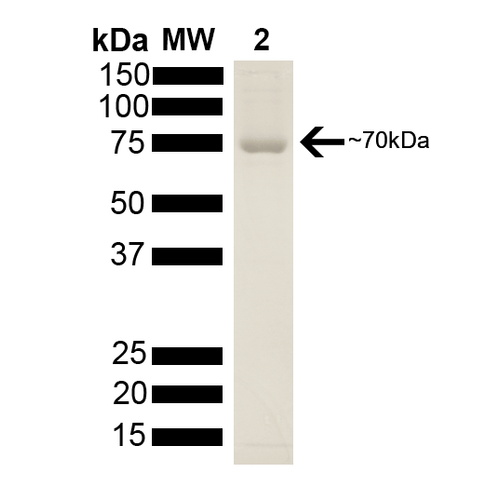SPR-108A SPR-103A SPR-115A SPR-117A SPR-108B SPR-103B SPR-115B SPR-117B +4
Scientist.com Supplier
HSP70 Protein
Stressmarq Biosciences
DESCRIPTION
Active Human Recombinant HSP70 Protein
DETAILS
- Nature: Recombinant
- Purity: >90%
- Target: HSP70
- Category: Protein
- Conjugate: His tag
- References: 1. Zho J. (1998) Cell. 94: 471-480. 2. Boorstein, W. R., Ziegelhoffer, T. & Craig, E. A. (1993) J. Mol. Evol. 38(1): 1-17. 3. Rothman J. (1989) Cell. 59: 591 -601. 4. DeLuca-Flaherty et al. (1990) Cell. 62: 875-887. 5. Bork P., Sander C. & Valencia A. (1992) Proc. Natl Acad. Sci. USA. 89: 7290-7294. 6. Fink A.L. (1999) Physiol. Rev. 79: 425-449. 7. Smith D.F., et al., (1993) Mol. Cell. Biol. 13(2): 869-876. 8. Prapapanich V., et al., (1996) Mol. Cell. Biol. 16(11): 6200-6207. 9. Fernandez-Funez et al., (2000) Nature. 408(6808): 101-106.
- Applications: WB | SDS-PAGE | ATPase Activity Assay | Functional Assay | ELISA
- Field of Use: Not for use in humans. Not for use in diagnostics or therapeutics. For research use only.
- Protein Size: ~70 kDa
- Purification: Affinity Purified
- Concentration: Lot/batch specific. See included datasheet.
- Research Areas: Cancer | Heat Shock | Cell Signaling | Protein Trafficking | Chaperone Proteins | Cancer | Tumor Biomarkers
- Storage Buffer: 50mM Tris/HCl, pH 7.5, 0.15M NaCl and 10% glycerol
- Alternative Names: HSP70 1 Protein, HSP70 2 Protein, HSP70.1 Protein, HSP72 Protein, HSP73 Protein, HSPA1 Protein, HSPA1A Protein, HSPA1B Protein
- Cite This Product: Human Recombinant HSP70 Protein (StressMarq Biosciences, Canada, Cat # SPR-103A)
- Expression System: E. coli
- Species Full Name: Human
- Amino Acid Sequence: MAKAAAIGIDLGTTYSCVGVFQHGKVEIIANDQGNRTTPSYVAFTDTERLIGDAAKNQVALNPQNTVFDAKRLIGRKFGDPVVQSDMKHWPFQVINDGDKPKVQVSYKGETKAFYPEEISSMVLTKMKEIAEAYLGYPVTNAVITVPAYFNDSQRQATKDAGVIAGLNVLRIINEPTAAAIAYGLDRTGKGERNVLIFDLGGGTFDVSILTIDDGIFEVKATAGDTHLGGEDFDNRLVNHFVEEFKRKHKKDISQNKRAVRRLRTACERAKRTLSSSTQASLEIDSLFEGIDFYTSITRARFEELCSDLFRSTLEPVEKALRDAKLDKAQIHDLVLVGGSTRIPKVQKLLQDFFNGRDLNKSINPDEAVAYGAAVQAAILMGDKSENVQDLLLLDVAPLSLGLETAGGVMTALIKRNSTIPTKQTQIFTTYSDNQPGVLIQVYEGERAMTKDNNLLGRFELSGIPPAPRGVPQIEVTFDIDANGILNVTATDKSTGKANKITITNDKGRLSKEEIERMVQEAEKYKAEDEVQRERVSAKNALESYAFNMKSAVEDEGLKGKISEADKKKVLDKCQEVISWLDANTLAEKDEFEHKRKELEQVCNPIISGLYQGAGGPGPGGFGAQGPKGGSGSGPTIEEVD
- Biological Activity: ATPase active
- Storage Temperature: -20ºC
- Shipping Temperature: Blue Ice or 4ºC
- Cellular Localization: Cytoplasm
- Scientific Background: HSP70 genes encode abundant heat-inducible 70-kDa HSPs (HSP70s). In most eukaryotes HSP70 genes exist as part of a multigene family. They are found in most cellular compartments of eukaryotes including nuclei, mitochondria, chloroplasts, the endoplasmic reticulum and the cytosol, as well as in bacteria. The genes show a high degree of conservation, having at least 50% identity (2). The N-terminal two thirds of HSP70s are more conserved than the C-terminal third. HSP70 binds ATP with high affinity and possesses a weak ATPase activity which can be stimulated by binding to unfolded proteins and synthetic peptides (3). When HSC70 (constitutively expressed) present in mammalian cells was truncated, ATP binding activity was found to reside in an N-terminal fragment of 44kDa which lacked peptide binding capacity. Polypeptide binding ability therefore resided within the C-terminal half (4). The structure of this ATP binding domain displays multiple features of nucleotide binding proteins (5). All HSP70s, regardless of location, bind proteins, particularly unfolded ones. The molecular chaperones of the HSP70 family recognize and bind to nascent polypeptide chains as well as partially folded intermediates of proteins preventing their aggregation and misfolding. The binding of ATP triggers a critical conformational change leading to the release of the bound substrate protein (6). The universal ability of HSP70s to undergo cycles of binding to and release from hydrophobic stretches of partially unfolded proteins determines their role in a great variety of vital intracellular functions such as protein synthesis, protein folding and oligomerization and protein transport. Looking for more information on HSP70? Visit our new HSP70 Scientific Resource Guide at http://www.HSP70.com.
- Certificate of Analysis: This product has been certified >90% pure using SDS-PAGE analysis. The protein has ATPase activity at the time of manufacture of 3.3µM phosphate liberated/hr/µg protein in a 200µl reaction at 37°C (pH7.5) in the presence of 20ul of 1mM ATP using a Malachite Green assay.
